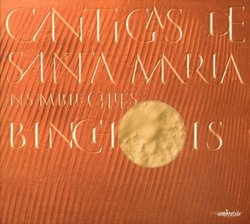| All Artists: Alfonso X el Sabio, Ensemble Gilles Binchois, Francoise Atlan, Anne-Marie Lablaude, Dominique Vellard, Emmanuel Bonnardot, Keyvan Chemirani Title: Cantigas de Santa Maria Members Wishing: 1 Total Copies: 0 Label: Ambroisie Release Date: 6/14/2005 Album Type: Import Genres: Pop, Classical Styles: Vocal Pop, Opera & Classical Vocal, Historical Periods, Early Music Number of Discs: 1 SwapaCD Credits: 1 UPC: 3760020170738 |
Search - Alfonso X el Sabio, Ensemble Gilles Binchois, Francoise Atlan :: Cantigas de Santa Maria
 | Alfonso X el Sabio, Ensemble Gilles Binchois, Francoise Atlan Cantigas de Santa Maria Genres: Pop, Classical
|
Larger Image |
CD Details |
CD ReviewsPolished and convincing Maddy Evil | London, UK | 12/30/2005 (5 out of 5 stars) "This recording presents twelve of Alfonso X's Cantigas (one of them incorporated into the famous 'El Cant de la Sibilla') and two instrumental realisations (one being repeated to serve as an epilogue).
As in many other modern performances of this repertory, the interpretations of Ensemble Gilles Binchois have been inspired by the idea of Berber influences on Alfonso's court, for which there is sound academic support. Their ensemble is a convincing size for a courtly setting (such as is depicted in the 'Prologo' [track 1] illumination, where Moorish influences are best justified), and it consists of 4 singers and 4 instrument groups: vielle (the favoured instrument of the Trouvere High Style repertory), lute/oud (the most depicted instrument group in the Cantiga illuminations), crwth (a relative of the harp, favoured by Troubadours), and Moorish percussion (the instruments used here being related examples of the darrabukka, which is depicted in the illumination for Cantiga 300). Overall, the performances are musically polished and academically convincing, and they are supported by interesting liner notes written by Troubadour scholar Pierre Bec. The contours and meters of the original melodies are respected, with the improvisations, introductions and ornaments being both sparse and economical. Anne-Marie Lablaude, Emmanuel Bonnardot and Dominique Vellard are at their best, both in terms of intonation and vocal timbre; they are joined by Francoise Atlan, who also contributes to the high performance standard here. Accompaniments are simple and effective (heterophonic or otherwise), and Keyvan Chemirani's percussion playing is outstanding. Perhaps the only gripes one might voice are the use of 15th century polyphony for the refrains of 'El Cant de la Sibilla' (which somewhat grates with the aura of the other tracks), and the use of two singers in the High Style-derived 'Tant'e Santa Maria' (track 12). [Incidentally, this musicological error occurs on other EGB discs of Troubadour/Trouvere monophony, such as on Les Escholiers de Paris. Motets, chansons et estampies. - Ensemble Gilles Binchois, Dominique Vellard (1992); no currently known evidence supports such interpretations for Canso/Chanson repertory, although it is unknown and as yet unproven whether the situation was more fluid in Spain.] In addition, the song texts are only translated into French, which may hinder the enjoyment of some listeners (these are, after all, narratives set to music!). Yet in spite of these points, this is still undoubtedly one of the best Cantiga recordings currently available." |

 Track Listings (16) - Disc #1
Track Listings (16) - Disc #1